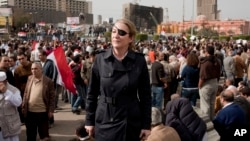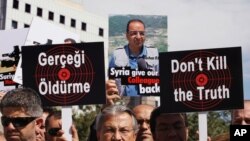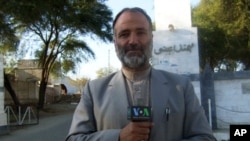UNITED NATIONS —
The year 2012 was one of the deadliest years for journalists, said the Committee to Protect Journalists on Thursday, with a total of 70 killed.
The high death toll was attributed to the conflict in Syria and violence against reporters in countries including Somalia and Pakistan. In its annual review of the dangers of journalism, another 232 reporters were jailed for their work.
Most of those targeted are local journalists reporting about human rights, politics, conflict, crime or corruption, said Robert Mahoney, the CPJ Deputy Director.
“From Mexico to Syria, Russia to Pakistan, journalists are on the front lines confronting violence and repression as never before," said Mahoney.
Syria was the deadliest country for reporters, with 28 killed in combat or targeted for murder by government or opposition forces. All but four of them were Syrian nationals covering their country’s conflict. Another 13 so-called “citizen journalists," who used their cameras and mobile phones to document the conflict in that country, also lost their lives.
In Somalia, it was the arrest and conviction last month of reporter Abdiaziz Abdinuur that has attracted international attention. He received a one-year prison sentence for insulting the government by interviewing a woman who said she was raped by government forces. The woman was also sentenced to one year in jail.
But in addition to the arrests, CPJ says at least a dozen reporters were murdered last year in Somalia. The militant group al-Shabaab claimed responsibility for four of them.
Mahoney noted that most of the time no one is ever prosecuted for a journalist’s murder, either in Somalia or elsewhere, creating an atmosphere of impunity. “It sends a terrible message to the journalism community if one of its own can be killed and nothing happens," he said.
CPJ said seven reporters were killed in Pakistan, including Mukarram Khan Aatif, who contributed to Voice of America’s Pashto-language Deewa Radio. He was gunned down in a mosque north of Peshawar. The Taliban claimed responsibility for that January 2012 attack.
In Latin America, journalists are harassed, intimidated and face serious threats from organized crime syndicates and corrupt officials.
CPJ Americas Director Carlos Lauria said four reporters were killed doing their work last year in Brazil. In Mexico, the situation is even more dangerous.
“In the last six years, more than 50 journalists have been killed or disappeared," he said. "Many reporters have been brutally attacked. Others have gone into exile. But perhaps the most devastating consequence of this wave of unprecedented violence is the climate of fear and intimidation in which journalists have to do their work, which is leading to rampant censorship.”
The report also expresses concerns about the widespread jailing of journalists under antiquated and restrictive laws used to silence anti-government dissent. The report cites Turkey, Iran, Vietnam, Ethiopia and Syria as major jailers.
Perhaps the report’s one bright spot is that for the first time since 2003, the rights group did not confirm a single work-related death among reporters in Iraq. Between 2003 and 2008, Iraq was one of the most dangerous places for reporters in the world, with a total of 151 journalists dying while covering that conflict.
The high death toll was attributed to the conflict in Syria and violence against reporters in countries including Somalia and Pakistan. In its annual review of the dangers of journalism, another 232 reporters were jailed for their work.
Most of those targeted are local journalists reporting about human rights, politics, conflict, crime or corruption, said Robert Mahoney, the CPJ Deputy Director.
“From Mexico to Syria, Russia to Pakistan, journalists are on the front lines confronting violence and repression as never before," said Mahoney.
Syria was the deadliest country for reporters, with 28 killed in combat or targeted for murder by government or opposition forces. All but four of them were Syrian nationals covering their country’s conflict. Another 13 so-called “citizen journalists," who used their cameras and mobile phones to document the conflict in that country, also lost their lives.
In Somalia, it was the arrest and conviction last month of reporter Abdiaziz Abdinuur that has attracted international attention. He received a one-year prison sentence for insulting the government by interviewing a woman who said she was raped by government forces. The woman was also sentenced to one year in jail.
But in addition to the arrests, CPJ says at least a dozen reporters were murdered last year in Somalia. The militant group al-Shabaab claimed responsibility for four of them.
Mahoney noted that most of the time no one is ever prosecuted for a journalist’s murder, either in Somalia or elsewhere, creating an atmosphere of impunity. “It sends a terrible message to the journalism community if one of its own can be killed and nothing happens," he said.
CPJ said seven reporters were killed in Pakistan, including Mukarram Khan Aatif, who contributed to Voice of America’s Pashto-language Deewa Radio. He was gunned down in a mosque north of Peshawar. The Taliban claimed responsibility for that January 2012 attack.
In Latin America, journalists are harassed, intimidated and face serious threats from organized crime syndicates and corrupt officials.
CPJ Americas Director Carlos Lauria said four reporters were killed doing their work last year in Brazil. In Mexico, the situation is even more dangerous.
“In the last six years, more than 50 journalists have been killed or disappeared," he said. "Many reporters have been brutally attacked. Others have gone into exile. But perhaps the most devastating consequence of this wave of unprecedented violence is the climate of fear and intimidation in which journalists have to do their work, which is leading to rampant censorship.”
The report also expresses concerns about the widespread jailing of journalists under antiquated and restrictive laws used to silence anti-government dissent. The report cites Turkey, Iran, Vietnam, Ethiopia and Syria as major jailers.
Perhaps the report’s one bright spot is that for the first time since 2003, the rights group did not confirm a single work-related death among reporters in Iraq. Between 2003 and 2008, Iraq was one of the most dangerous places for reporters in the world, with a total of 151 journalists dying while covering that conflict.














